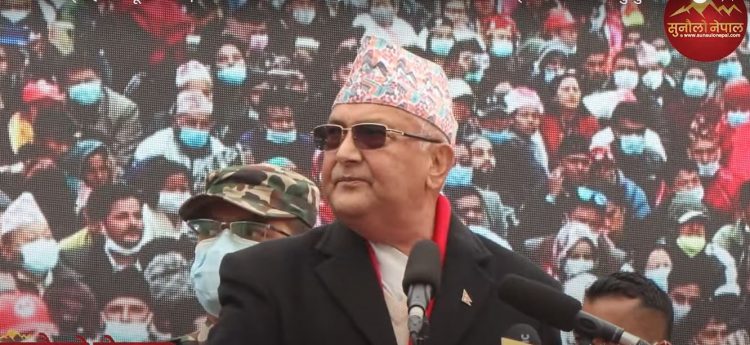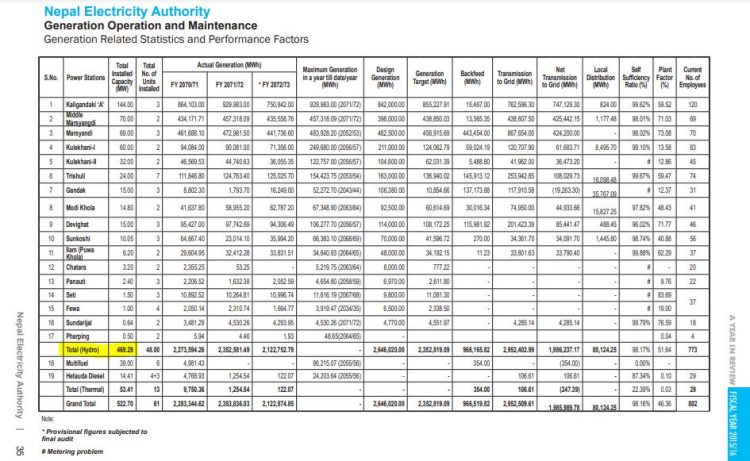PM made four false claims in two recent speeches
South Asia Check / February 7, 2021

Photo: Sunaulo Nepal’s Youtube channel
By Deepak Adhikari
Having dissolved the House of Representatives and announcing general elections, Prime Minister KP Sharma Oli has recently addressed several rallies across the country. In his speeches, Oli defended his government’s move and highlighted its various achievements of the last three years of his tenure, and his previous stint as prime minister. On February 5, 2021, addressing a rally at Durbar Marg in Kathmandu, he said: “Some people have spread various misleading information about me.” But a fact-check of his recent speeches by South Asia Check found that the prime minister himself has been repeating some claims that have already been debunked by fact-checkers.
First claim
“During the inauguration of the substation (in Dhalkebar) today, I said 111 years ago, in 1911, hydropower was generated in Nepal from the Chandra Jyoti [named after then Rana prime minister Chandra Shumsher] Hydropower Station. Until six years ago, Nepal would not generate even 300 megawatts (MW) in total. Although Nepal was the first South Asian country to generate hydropower, it generated around 3 MW of electricity per year in the 105 years after the first hydropower project. When I became prime minister, the country was seeing 18 hours of power outage daily. But within a week of my prime ministership while addressing a Dashain festival function I announced that the next year’s Tihar festival [festival of lights] will not be celebrated in darkness. So, in order to meet the goal, my government bought electricity from India and [Indian Prime Minister Narendra] Modi Ji and I inaugurated the construction of Dhalkebar-Muzaffarpur cross-border transmission line. ” [Go to 5 mins 15 seconds into the video]
Oli made the remarks at a meeting of the Progressive Engineering Association Nepal in Kathmandu on February 1, 2021. Before addressing the February 1 gathering, Oli had inaugurated the Dhalkebar substation, the country’s largest. Although some of Oli’s claims in this statement were true, two claims are false.
The 500-kilowatt hydropower station in Pharping on the outskirts of Kathmandu, inaugurated by King Prithvi Bir Bikram Shah when Chandra Shumsher Janga Bahadur Rana was prime minister, is Nepal’s first hydropower project but it was not the first in South Asia.
According to the Indian newspaper Times of India, India started operation of a 130-kilowatt hydroelectric project in Darjeeling in 1897. Similarly, India’s first major power station – a 4.5 MW hydropower project on the Cauvery River in Karnataka – was commissioned in 1902. Therefore, it’s wrong to say Nepal’s Chandra Jyoti Hydropower Plant was the first hydroelectricity project in South Asia.
Oli’s another claim is also wrong. He claimed that Nepal generated less than 300 MW of hydroelectricity before his first stint as prime minister in 2015. According to Nepal Electricity Authority’s annual report for 2015/16, Nepal’s installed hydropower capacity at the time was 469.29 MW. Therefore, Oli’s claim that Nepal’s generated less than 300 MW when he first became the prime minister is wrong.

Second claim
“A so-called Nepal banda (nationwide shutdown) was called yesterday [February 4] in an attempt to prevent you from attending this rally. What did they do to enforce their shutdown? They claim that they work for the poor, but instead of helping the working class, they spilled the vegetables of an elderly roadside woman vendor on the street in their attempt to start a revolution.” [Go to 2 mins 25 seconds into the video]
Prime Minister Oli made the remarks while addressing a rally at Durbar Marg in Kathmandu on February 5. Oli was referring to some photos, which had gone viral on the social media and purportedly showed the enforcers of the February 4 shutdown, which was called by the Prachanda-Madhav faction of the Nepal Communist Party, spilling vegetables on the street. An investigation by Nepal Factcheck, a Nepali factchecking website, into the viral photos found that the photos were from a farmers’ protest in the Indian state of Maharashtra and a protest by vegetable farmers in Nepal three years ago. Prime Minister Oli has spread misinformation such as this by repeatedly making claims that have already been debunked by factcheckers.
Third claim
“The United Kingdom does not have a written constitution. In other words, nowhere it is written that a British prime minister can dissolve parliament. Such thing is not written in any form. But the [British] prime minister recently dissolved parliament and held elections.”
Prime Minister Oli made the claim at the February 5 rally at Durbar Marg to defend his dissolution of parliament. It’s true that the UK does not have a written constitution. But it is incorrect to claim that there is no law [in the UK] that allows the prime minister to dissolve parliament. The UK’s Fixed Term Parliaments Act gives the prime minister the power to dissolve parliament under certain conditions.
In the UK, there is a separate and written law on the dissolution of parliament. Laws such as the Magna Carta, the Bill of Rights, and the Parliament Act address major constitutional issues, according to the BBC.
According to an explainer published in The Conversation, the tradition in which the prime minister requested the monarch to dissolve the parliament ended in the UK after the country enacted the Fixed-term Parliaments Act in 2011. The idea behind the Act was to curtail the power of the prime minister to dissolve parliament before completing the five-year term. Nevertheless, the Act has made two exceptions:
- If a motion for an early election is agreed by at least 434 MPs out of 650 (a two-thirds majority), or
- if a motion of no confidence is passed and no alternative government is formed within 14 days.
The latest dissolution of the UK’s Parliament occurred in 2019 and elections were held in December that year. Prime Minister Boris Johnson dissolved the House of Commons in 2019. He had cited the first of the above exceptions to dissolve the House.
Fourth claim
“In Nepal, the Covid-19 mortality rate is low. The treatment is good. What was the situation like [in the early days of the pandemic]? There’s was no treatment. Today, 82 laboratories simultaneously conduct swab tests for Covid-19 infections every day. Today, people are being vaccinated at more than 300 booths. ” [Go to 26 mins 19 seconds into the video]
This remark by the prime minister came as part of his claim that the death toll from Covid-19 has decreased as a result of the measures taken by his government. Although his claim that Covid-19 tests are conducted daily in 82 laboratories is true, the prime minister exaggerated the actual number of vaccination booths. According to the Ministry of Health, on February 1, people were vaccinated from 191 booths in 77 districts. The number of vaccine booths recently reached 201. So, the prime minister’s claim about the booth numbers is a gross overstatement.
This material is copyrighted but may be used for any purpose by giving due credit to southasiacheck.org.
Comments
Latest Stories
- In Public Interest Covid-19 cases are low, but that’s not an excuse to avoid vaccination
- In Public Interest What is BF.7, the sub-variant that has the world by its grip?
- In Public Interest Threat of a new Covid-19 wave looms large amid vaccine shortage in Nepal
- In Public Interest As cases decline, Covid-19 test centres in Kathmandu are desolate lot
- In Public Interest Dengue test fee disparity has patients wondering if they’re being cheated
- In Public Interest As dengue rages on, confusion galore about what it is and what its symptoms are. Here’s what you need to know
In Public Interest
 Covid-19 cases are low, but that’s not an excuse to avoid vaccination
The Pfizer-BioNTech bivalent vaccines authorised by the Nepal Government provide better protection a...
Read More
Covid-19 cases are low, but that’s not an excuse to avoid vaccination
The Pfizer-BioNTech bivalent vaccines authorised by the Nepal Government provide better protection a...
Read More
- What is BF.7, the sub-variant that has the world by its grip?
- Threat of a new Covid-19 wave looms large amid vaccine shortage in Nepal
- As cases decline, Covid-19 test centres in Kathmandu are desolate lot
- Dengue test fee disparity has patients wondering if they’re being cheated
- As dengue rages on, confusion galore about what it is and what its symptoms are. Here’s what you need to know